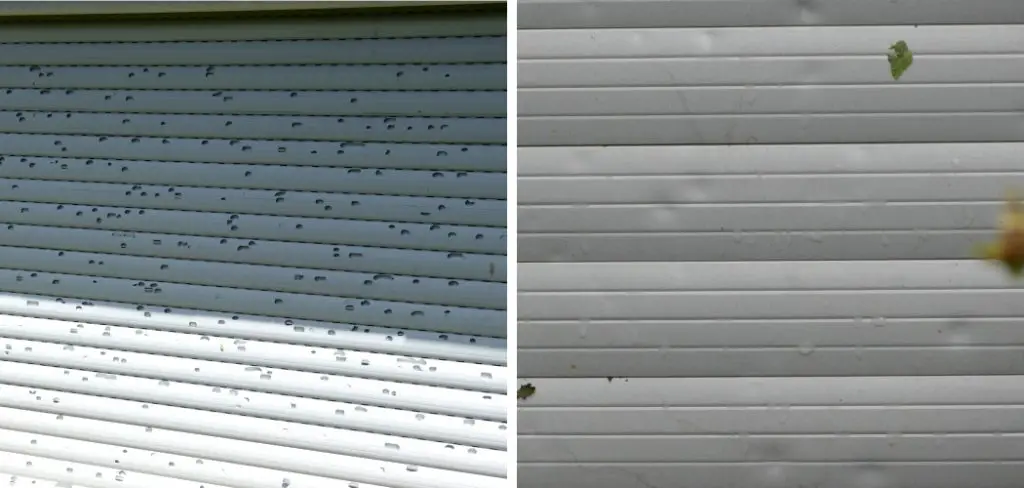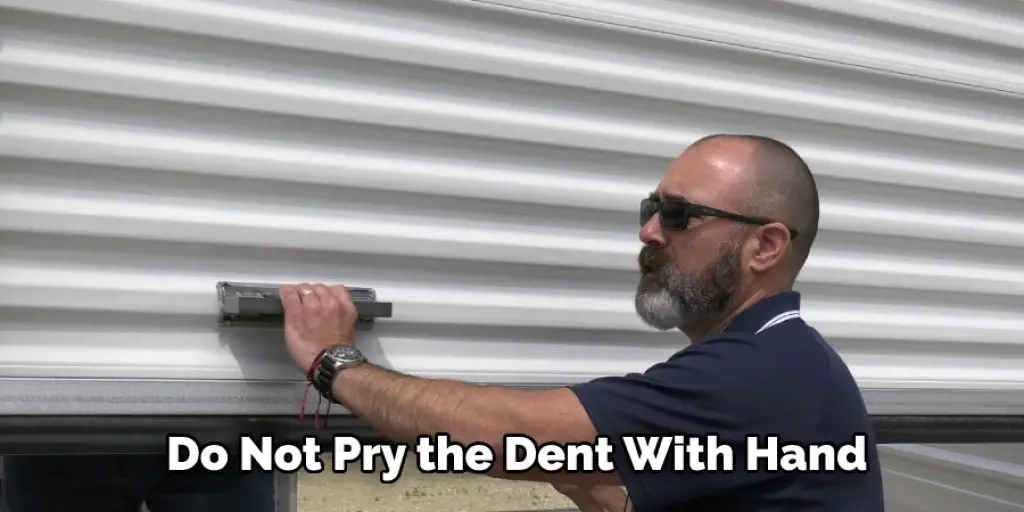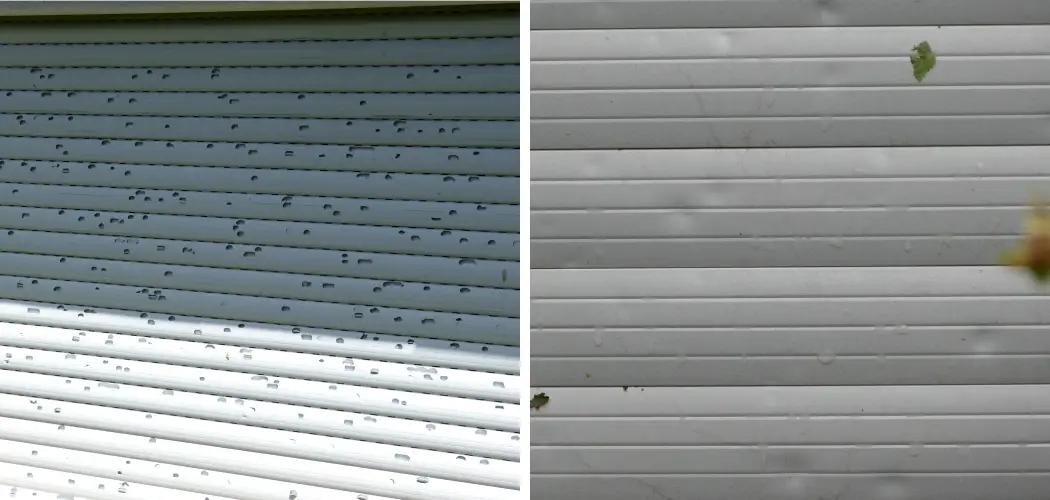Dented garage doors are a common sight. Unfortunately, these dents can be an eyesore, whether it’s from someone trying to squeeze their car in too tight or a wayward ball. But don’t worry – there is a way to fix them without calling a professional! This article will show you how to get a dent out of a garage door. Keep reading for all the details.

The garage is one of the most critical places in our house. It’s where we store our car, our tools, and other valuables. But over time, even the sturdiest garage doors can succumb to dents and scratches. While these blemishes may not seem like a big deal, they can devalue your home and make it look unkempt. If you have a dent in your garage door, you can do a few things to remove it.
Summary: Getting a dent out of a garage door can be quite easy and cost-effective and save you from replacing the entire door. One way to do it is by using a plunger or suction cup. Another option is to use a heat source, such as a hairdryer or heat gun, to expand the metal and then use a tool to push the dent out from the inside of the door. You can also try using a hammer and block of wood to tap the dent out slowly.
A Step by Step Guide How to Get a Dent Out of a Garage Door
Step 1: Assess the Damage
Examine the dent in your garage door and assess the extent of the damage. Take note of the size, depth, and location of the dent, as well as the material your garage door is made of (e.g., aluminum, steel, or wood). This information will help you determine the best method for removing the dent.
Step 2: Gather Necessary Tools and Supplies
Depending on the chosen method and the garage door’s material, gather the necessary tools and supplies. Some common items you may need include:
- Plunger
- Bucket of warm water
- Dish soap
- Soft cloth or sponge
- Compressed air canister
- Hairdryer or heat gun
- Aluminum foil
- Heavy-duty gloves
- Wooden block or rubber mallet
- Automotive body filler (for steel or aluminum doors)
- Sandpaper
- Primer and paint (if needed)
Step 3: Clean the Dented Area
Before attempting to remove the dent, clean the area with a soft cloth or sponge, warm water, and a few drops of dish soap. This will help to remove any dirt or debris that could interfere with the dent removal process. Rinse the area with clean water and allow it to dry completely.
Step 4: Choose an Appropriate Dent Removal Method
Select a dent removal method based on the garage door’s material and the extent of the damage. Some common methods include:
- Plunger method: Suitable for shallow dents on steel or aluminum garage doors.
- Heat and cold method: Effective for small to medium-sized dents on aluminum doors.
- Hammer and wooden block method: Applicable for shallow dents on wooden garage doors or as a supplementary technique for metal doors.
- Automotive body filler method: Ideal for larger or deeper dents on steel or aluminum garage doors.
Step 5: Apply the Chosen Dent Removal Method
Follow the steps for the chosen dent removal method:
- Plunger method: Wet the plunger and the dented area with water. Place the plunger over the dent and push it in firmly. Pull the plunger out with a quick, forceful motion to create suction and potentially pop the dent out.
- Heat and cold method: Cover the dent with a piece of aluminum foil. Wearing heavy-duty gloves, use a hairdryer or heat gun to heat the dented area for 2-3 minutes. Remove the foil and immediately spray the area with compressed air for 10-15 seconds. The rapid temperature change may cause the dent to pop out.
- Hammer and wooden block method: Place a wooden block or rubber mallet over the dented area on the inside of the garage door. Gently tap the block or mallet with a hammer to push the dent outward. Take care not to apply too much force or damage the door further.
- Automotive body filler method: Sand the dented area with coarse-grit sandpaper to roughen the surface. Mix and apply the body filler according to the manufacturer’s instructions. Allow the filler to dry, then sand it down with fine-grit sandpaper to create a smooth surface. Prime and paint the area to match the rest of the garage door.
Step 6: Inspect the Garage Door
After applying the dent removal method, inspect the garage door to ensure the dent is adequately repaired. If the dent is still visible or the door’s surface is uneven, consider repeating the process or trying a different method.
Step 7: Touch Up the Paint (If Needed)
If the dent removal process has resulted in paint chipping or peeling, touch up the affected area with primer and paint that match the garage door’s existing color. Follow the paint manufacturer’s instructions for application and drying times.
Step 8: Perform Regular Maintenance and Inspections
To prevent future dents and maintain your garage door’s appearance and functionality, regularly inspect and maintain the door. Lubricate moving parts, tighten hardware, and check the door’s balance and alignment. Address any issues promptly to prevent further damage.
Step 9: Protect Your Garage Door from Potential Damage
Take precautions to protect your garage door from potential damage. This may include installing foam padding or rubber bumpers along the door’s edges or the garage’s interior walls. Additionally, be mindful when parking vehicles, using lawn equipment, or playing sports near the garage door to minimize the risk of accidental dents.
Step 10: Educate Family Members and Housemates
Ensure that all family members and housemates are aware of the importance of garage door maintenance and the proper use of the garage door. Educating everyone in the household about the potential causes of garage door dents can help prevent future incidents.
Step 11: Know When to Call a Professional
If the dent in your garage door is severe, extensive, or located in a critical area that affects the door’s operation, it may be best to consult a garage door professional for repairs. Attempting to fix a large or complex dent yourself may result in further damage or compromise the door’s safety and functionality.
By following these steps, you can effectively remove a dent from your garage door and restore its appearance and function. Regular maintenance, preventive measures, and education can help prevent future dents and keep your garage door in good working order. Always prioritize safety when working with garage doors, and consult a professional if you are unsure about how to handle a repair or if the dent is severe.
Tips and Warnings
Tips
- If the dent is small, try using a plunger to push it out from the inside.
- For more significant dents, use a rubber mallet to gently tap around the perimeter of the mark until it pops out.
- To avoid damaging the door, put a piece of wood or cardboard underneath the mallet before striking.
- If the dent is in an accessible area, you can also try using a plunger or a rubber mallet to push it out from the outside.
- For deep dents, you may need to use a drill to make a hole in the center of the dent and then use a screwdriver or another tool to pry it out.
- If the dent is in a complex area to reach, you may need to call a professional for help.
Warnings
- Do not use a metal object to tap on the dent, as this could cause further damage.
- Do not try to pry the dent out with your hands, as this could also cause further damage.
- If you are unsure how to proceed, it is always best to call a professional for help.

Do Dent Suction Cups Work?
We have all seen those commercials where someone is trying to sell a product that promises to remove dents from cars without having to repaint the vehicle. The same products are marketed for use on garage doors. But do they work?
Dent suction cups can create enough of a seal to pull out tiny dents. But they will not work on large dents, and they can cause more damage if not used correctly.
Be very careful if you decide to try using a dent suction cup. Ensure that the cup is clean and dry before attaching it to the door. If there is any dirt or debris on the cup, it could scratch the door.
Attach the cup to the door and then push down the handle to create suction. Once the cup is attached, you will need to pull up on the cup to remove the dent. Be careful not to pull too hard, as this could damage the door.
If you can remove the dent, you will likely see a small divot where the dent was. This is normal and can be filled with putty or caulk.
If you cannot remove the dent or if the dent is too significant, you will need to call a professional for help. Trying to remove a large dent yourself could cause more damage to your garage door.
Does Boiling Water Fix Car Dents?
Boiling water can be a pretty effective way to remove more minor dents from your car. How it works is the heat from the boiling water will cause the metal to expand, and this expansion will help to pop the dent out.
Now, it’s important to note that this method will only work on more minor dents. So if you have a significant dent or one located in a difficult spot, you are then boiling water probably won’t do the trick. But if you’ve got a small dent that you want to try and remove, then give it a shot!
Conclusion
Now that you know how to get a dent out of a garage door, it’s time to put your skills to the test! Be sure to practice on a piece of scrap metal before tackling your solid garage door, and remember to use caution when working with power tools. With a little bit of elbow grease, you should be able to remove any dent from your garage door in no time. Let us know how it goes.
You Can Check It Out To Vent Car Exhaust in Garage

